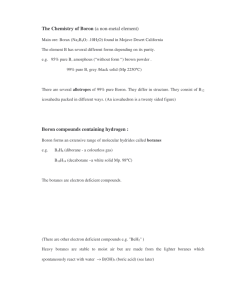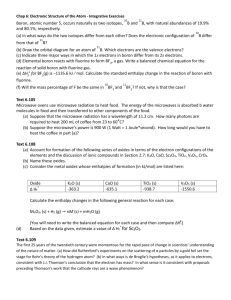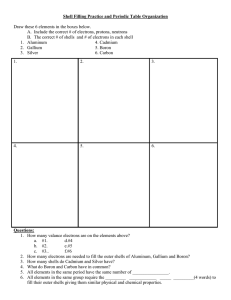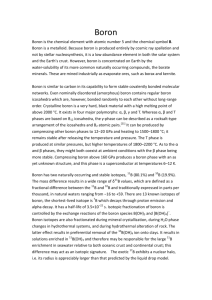Oregon Wine Advisory Board Research Progress Report 1989 Boron Update
advertisement
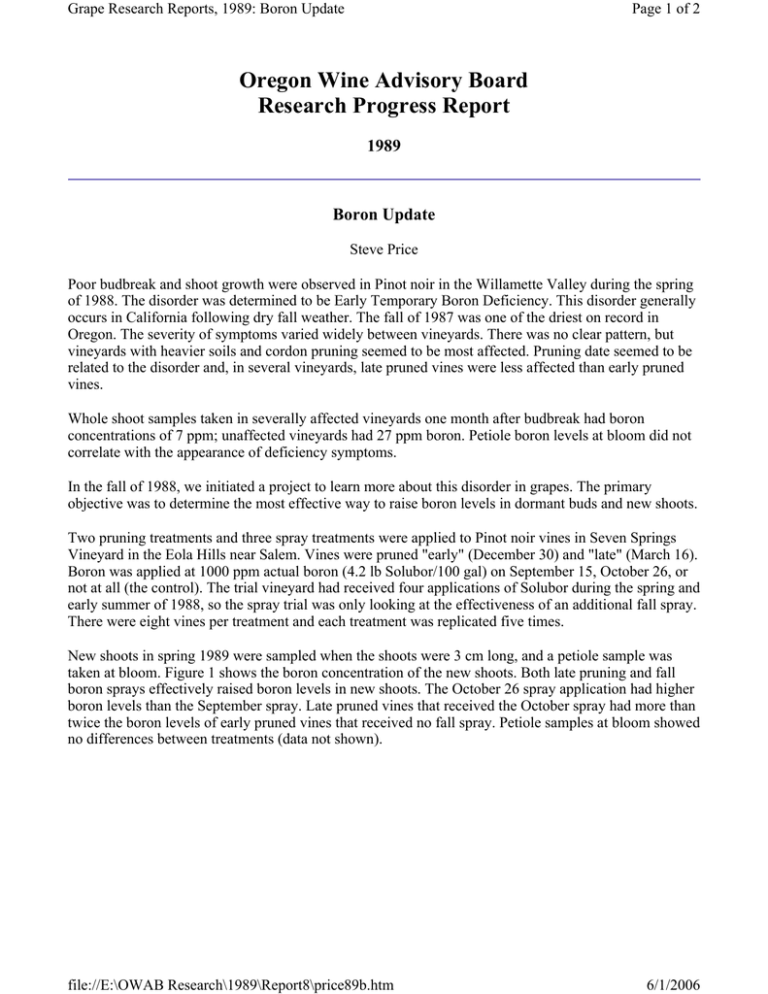
Grape Research Reports, 1989: Boron Update Page 1 of 2 Oregon Wine Advisory Board Research Progress Report 1989 Boron Update Steve Price Poor budbreak and shoot growth were observed in Pinot noir in the Willamette Valley during the spring of 1988. The disorder was determined to be Early Temporary Boron Deficiency. This disorder generally occurs in California following dry fall weather. The fall of 1987 was one of the driest on record in Oregon. The severity of symptoms varied widely between vineyards. There was no clear pattern, but vineyards with heavier soils and cordon pruning seemed to be most affected. Pruning date seemed to be related to the disorder and, in several vineyards, late pruned vines were less affected than early pruned vines. Whole shoot samples taken in severally affected vineyards one month after budbreak had boron concentrations of 7 ppm; unaffected vineyards had 27 ppm boron. Petiole boron levels at bloom did not correlate with the appearance of deficiency symptoms. In the fall of 1988, we initiated a project to learn more about this disorder in grapes. The primary objective was to determine the most effective way to raise boron levels in dormant buds and new shoots. Two pruning treatments and three spray treatments were applied to Pinot noir vines in Seven Springs Vineyard in the Eola Hills near Salem. Vines were pruned "early" (December 30) and "late" (March 16). Boron was applied at 1000 ppm actual boron (4.2 lb Solubor/100 gal) on September 15, October 26, or not at all (the control). The trial vineyard had received four applications of Solubor during the spring and early summer of 1988, so the spray trial was only looking at the effectiveness of an additional fall spray. There were eight vines per treatment and each treatment was replicated five times. New shoots in spring 1989 were sampled when the shoots were 3 cm long, and a petiole sample was taken at bloom. Figure 1 shows the boron concentration of the new shoots. Both late pruning and fall boron sprays effectively raised boron levels in new shoots. The October 26 spray application had higher boron levels than the September spray. Late pruned vines that received the October spray had more than twice the boron levels of early pruned vines that received no fall spray. Petiole samples at bloom showed no differences between treatments (data not shown). file://E:\OWAB Research\1989\Report8\price89b.htm 6/1/2006 Grape Research Reports, 1989: Boron Update Page 2 of 2 Although these results are preliminary (the trial will be repeated in 1989), there are several important points that growers may wish to note. 1) Fall sprays can raise boron levels in new growth. 2) Postharvest sprays are more effective than preharvest sprays. This was a surprise. When the October spray was applied, 50% of the leaves had fallen and 90% of the remaining leaves were yellow. It would appear that bud contact may be more important than leaf contact. 3) Pruning date will, indeed, affect spring boron levels. 4) Petiole analysis is not a good guide for early season boron disorders. Growers who experienced severe problems in 1988 should consider making a fall boron spray and late pruning part of their general management program for Pinot noir. Neither of these options is expensive, and if they can eliminate some of the crop loss experienced in 1988, they will be worthwhile. In addition to repeating this trial, we will be investigating several new ideas this fall. This fall's trials will have a handdefoliated treatment to learn more about the effects of bud vs. leaf contact; the fall sprays will be continued into the winter to determine how effective very late sprays will be; and we will be following winter boron levels to learn more about the late pruning effect. A complete report on our boron research program will appear in the WAB Research Report at the conclusion of the project. file://E:\OWAB Research\1989\Report8\price89b.htm 6/1/2006

